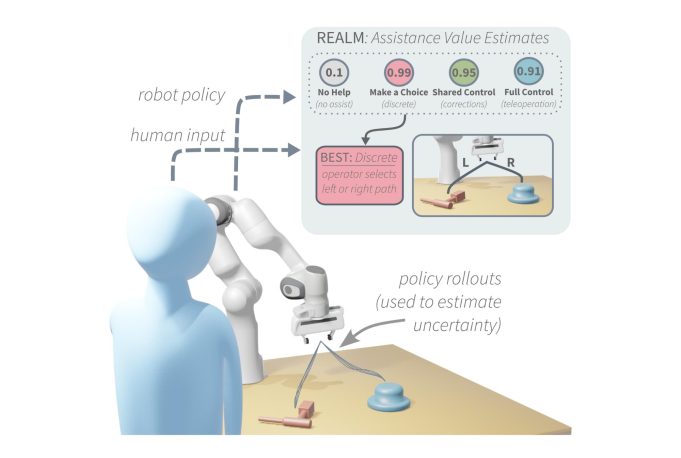
REALM: Real-time estimates of assistance for learned models in human-robot interaction
Postdoctoral researcher Michael Hagenow and Prof. Julie Shah (Interactive Robotics Group) developed a method that helps robots choose the most effective way to ask for human help by balancing how much the input reduces the robot’s uncertainty against the effort required from the human. By estimating uncertainty reductions for different types of interventions, such as partial control, full teleoperation, and selecting between options, the approach reduces the human effort needed for robots to complete uncertain tasks.
Authors: Michael Hagenow and Julie Shah
Citation: IEEE Robotics and Automation Letters, vol. 10, no. 6, pp. 5473-5480, June 2025
Abstract:
There are a variety of mechanisms (i.e., input types) for real-time human interaction that can facilitate effective human-robot teaming. For example, previous works have shown how teleoperation, corrective, and discrete (i.e., preference over a small number of choices) input can enable robots to complete complex tasks. However, few previous works have looked at combining different methods, and in particular, opportunities for a robot to estimate and elicit the most effective form of assistance given its understanding of a task.
In this paper, we propose a method for estimating the value of different human assistance mechanisms based on the action uncertainty of a robot policy. Our key idea is to construct mathematical expressions for the expected post-interaction differential entropy (i.e., uncertainty) of a stochastic robot policy to compare the expected value of different interactions. As each type of human input imposes a different requirement for human involvement, we demonstrate how differential entropy estimates can be combined with a likelihood penalization approach to effectively balance feedback informational needs with the level of required input. We demonstrate evidence of how our approach interfaces with emergent learning models (e.g., a diffusion model) to produce accurate assistance value estimates through both simulation and a robot user study. Our user study results indicate that the proposed approach can enable task completion with minimal human feedback for uncertain robot behaviors.

